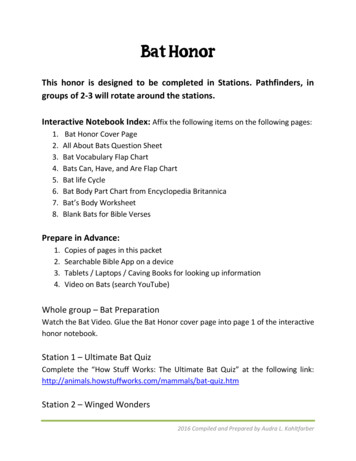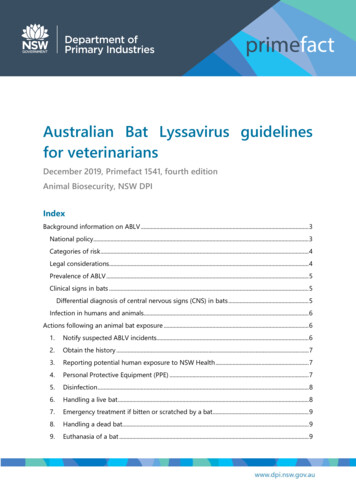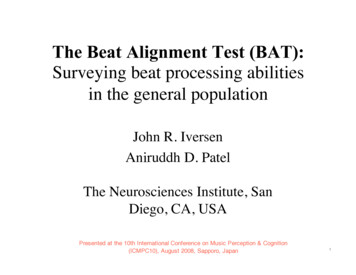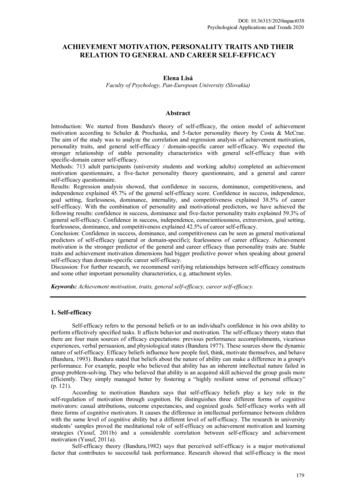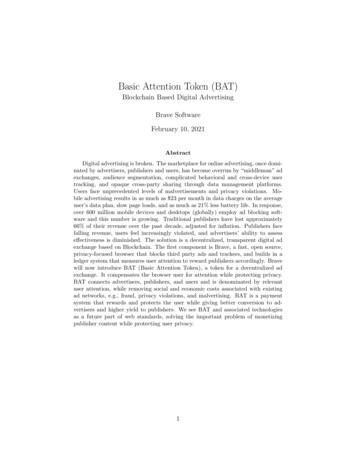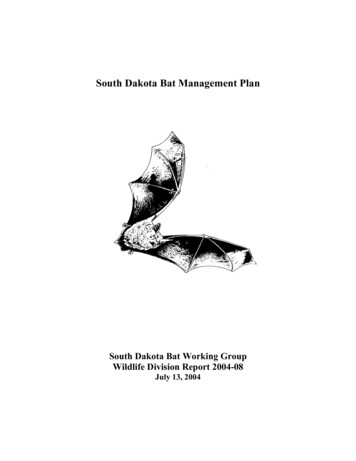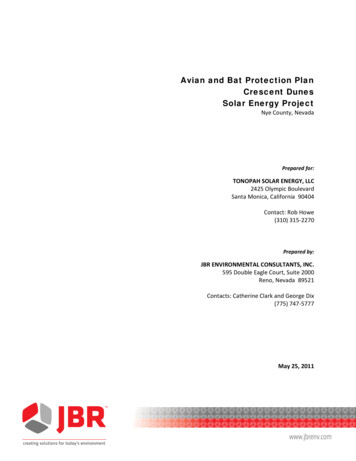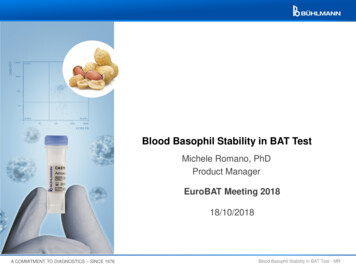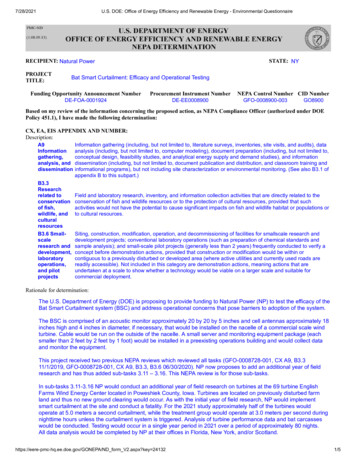
Transcription
7/28/2021U.S. DOE: Office of Energy Efficiency and Renewable Energy - Environmental QuestionnaireSTATE: NYRECIPIENT: Natural PowerPROJECTTITLE:Bat Smart Curtailment: Efficacy and Operational TestingFunding Opportunity Announcement NumberProcurement Instrument NumberDE-FOA-0001924DE-EE0008900NEPA Control Number CID NumberGFO-0008900-003GO8900Based on my review of the information concerning the proposed action, as NEPA Compliance Officer (authorized under DOEPolicy 451.1), I have made the following determination:CX, EA, EIS APPENDIX AND , anddisseminationB3.3Researchrelated toconservationof fish,wildlife, andculturalresourcesB3.6 Smallscaleresearch anddevelopment,laboratoryoperations,and pilotprojectsInformation gathering (including, but not limited to, literature surveys, inventories, site visits, and audits), dataanalysis (including, but not limited to, computer modeling), document preparation (including, but not limited to,conceptual design, feasibility studies, and analytical energy supply and demand studies), and informationdissemination (including, but not limited to, document publication and distribution, and classroom training andinformational programs), but not including site characterization or environmental monitoring. (See also B3.1 ofappendix B to this subpart.)Field and laboratory research, inventory, and information collection activities that are directly related to theconservation of fish and wildlife resources or to the protection of cultural resources, provided that suchactivities would not have the potential to cause significant impacts on fish and wildlife habitat or populations orto cultural resources.Siting, construction, modification, operation, and decommissioning of facilities for smallscale research anddevelopment projects; conventional laboratory operations (such as preparation of chemical standards andsample analysis); and small-scale pilot projects (generally less than 2 years) frequently conducted to verify aconcept before demonstration actions, provided that construction or modification would be within orcontiguous to a previously disturbed or developed area (where active utilities and currently used roads arereadily accessible). Not included in this category are demonstration actions, meaning actions that areundertaken at a scale to show whether a technology would be viable on a larger scale and suitable forcommercial deployment.Rationale for determination:The U.S. Department of Energy (DOE) is proposing to provide funding to Natural Power (NP) to test the efficacy of theBat Smart Curtailment system (BSC) and address operational concerns that pose barriers to adoption of the system.The BSC is comprised of an acoustic monitor approximately 20 by 20 by 5 inches and cell antennas approximately 18inches high and 4 inches in diameter, if necessary, that would be installed on the nacelle of a commercial scale windturbine. Cable would be run on the outside of the nacelle. A small server and monitoring equipment package (eachsmaller than 2 feet by 2 feet by 1 foot) would be installed in a preexisting operations building and would collect dataand monitor the equipment.This project received two previous NEPA reviews which reviewed all tasks (GFO-0008728-001, CX A9, B3.311/1/2019, GFO-0008728-001, CX A9, B3.3, B3.6 06/30/2020). NP now proposes to add an additional year of fieldresearch and has thus added sub-tasks 3.11 – 3.16. This NEPA review is for those sub-tasks.In sub-tasks 3.11-3.16 NP would conduct an additional year of field research on turbines at the 69 turbine EnglishFarms Wind Energy Center located in Poweshiek County, Iowa. Turbines are located on previously disturbed farmland and thus no new ground clearing would occur. As with the initial year of field research, NP would implementsmart curtailment at the site and conduct a fatality. For the 2021 study approximately half of the turbines wouldoperate at 5.0 meters a second curtailment, while the treatment group would operate at 3.0 meters per second duringnighttime hours unless the curtailment system is triggered. Analysis of turbine performance data and bat carcasseswould be conducted. Testing would occur in a single year period in 2021 over a period of approximately 80 nights.All data analysis would be completed by NP at their offices in Florida, New York, and/or Scotland.https://eere-pmc-hq.ee.doe.gov/GONEPA/ND form V2.aspx?key 241321/5
7/28/2021U.S. DOE: Office of Energy Efficiency and Renewable Energy - Environmental QuestionnaireThere are four Endangered Species Act listed species (hereinafter, listed species) that could be present at the chosenstudy sites. There is no critical habitat at the proposed study sites. As such, NP prepared a Biological Evaluationanalyzing potential impacts of the additional year proposed study (May 20212 BE). DOE has determined that theproposed project would have No Effect on two listed species, the Prairie Bush-clover and the Western Prairie FringedOrchid. DOE has determined that the proposed 2021 study May Effect and is Likely to Adversely Affect two listedspecies, the Indiana bat and the northern long-eared bat, and may result in an incidental take of 1 Indiana bats and 1northern long-eared bat at the study sites over the one year study. DOE further has determined that the proposedproject would not jeopardize the continued existence of either species. On May 18, 2020, DOE engaged in formalconsultation with the United States Fish and Wildlife Service (USFWS) regarding the potential impacts to listedspecies of the 2020 study. On June 24, 2020, USFWS issued a Biological Opinion concurring with DOE’s opinion,issuing an Incidental Take Statement (ITS), and mandating Reasonable and Prudent Measures as well as Terms andConditions, and Monitoring and Reporting Requirements. On June 30, 2021 DOE re-initiated consultation withUSFWS in regards to the proposed 2021 study. On July 26, 2021 USFWS issues a letter on the re-initiation whichincluded an Incidental Take Statement (ITS), and mandating Reasonable and Prudent Measures as well as Terms andConditions, and Monitoring and Reporting Requirements.USFWS issued an ITS finding that the action is expected to take up to one Indiana bats and up to one northern longeared bat. Because the northern long-eared bat is subject to a 4(d) rule, take is not prohibited. As such, the USFWSissued Reasonable and Prudent Measures and Terms and Conditions are in regards to the Indiana bat only.Monitoring and Reporting Requirements apply to both the Indiana bat and the northern long-eared bat. Thesemeasures are non-discretionary requirements of the ITS. DOE is allowed to (and will) require that the grant recipient(Natural Power) fulfill the mandated measures.Reasonable and Prudent Measures: In order to reduce Indiana bat mortality at the site, study turbine blades must be feathered below the cut-in speedsdescribed in the May 2021 BE. The DOE must report to the Service on whether or not the feathering of turbine blades was implementedsuccessfully at the study turbines.Terms and Conditions: The DOE must report to the Service on whether or not the feathering of turbine blades was implementedsuccessfully at the study turbines. If fatality monitoring at the proposed project indicates that take of Indiana bats or northern long-eared bats mayexceed the expected levels analyzed in the BO and approved in the reinitiation approval letter, (one Indiana bat andone northern long-eared bat over the second year of the study period) the DOE and partners should reinitiateconsultation and reevaluate the effects of the take on the species. If a carcass of either an Indiana or northern long-eared bat is discovered in the project area, the Illinois – Iowa FieldOffice should be notified within one business day of positive identification. Results of the research, including statistical analyses, calculated fatality estimates, summaries of monitoring efforts,searcher efficiency calculations, and carcass removal times should be provided to the Service upon conclusion of theresearch. Should the results demonstrate conservation value to the Indiana bat, northern long-eared bat, or otherwildlife, we request that the DOE, grantee, and/or partners allow for the dissemination of the research results andconclusions among Service personnel to enable others to apply the technique evaluated during the study as a wildlifeconservation measure at wind facilities.In addition USFWS mandated specific Monitoring and Reporting Requirements as follows: After the first year of the study, recipient will discuss the results with the DOE and the Service regarding theobserved effectiveness of the research. If interim reports are prepared, a copy should be provided to DOE and theService after the first year of the study. Following the second year of study and the completion of the research a copyof the final report should be provided to DOE and to the Service. The DOE and partners shall process the results of fatality monitoring using Evidence of Absence Software, v2.0 orlater (Dalthorp et al. 2017). An estimation of fatalities of Indiana and northern long-eared bats should be providedusing an alpha level of 0.5 to calculate M* and lambda outputs by the program. The take estimate should beconducted after the first year of the study, and a projection of the cumulative take expected after the conclusion of thesecond year of study should be provided. The DOE, grantee, and partners (those conducting the field research) are authorized under this BO to collect andhandle covered bat species found incidentally or during fatality monitoring associated with the research. The collectionand disposition of covered bat species, including non-living specimens (whole carcasses or body parts), injured livehttps://eere-pmc-hq.ee.doe.gov/GONEPA/ND form V2.aspx?key 241322/5
7/28/2021U.S. DOE: Office of Energy Efficiency and Renewable Energy - Environmental Questionnairespecimens, or grounded, uninjured live specimens shall be conducted by qualified individuals, as defined below.i. Properly qualified for collection of non-living covered bat remains means that any surveyor must be properly trainedby the DOE or partners in carcass handling and collection protocols, including data collection, recording, andprotection. The surveyor must have knowledge of and take all reasonable precautions to prevent harm to the self andothers as a result of handling non-living remains. Also, all applicable federal, state, and local laws relating to thecollection and disposition of wildlife remains should be followed by the surveyor.ii. Properly qualified for handling of living, but injured or grounded covered bat specimens means that any surveyormust be properly trained by a person holding a valid ESA section 10(a)(1)(A) recovery permit for bats from theService. The surveyor must have knowledge of and take all reasonable precautions to prevent harm to the self,others, and the animal as a result of handling living covered bat specimens. Also, all other applicable federal, state,and local laws and guidelines relating to the collection and disposition of wildlife specimens should be followed by thesurveyor.iii. Properly qualified for the identification of the non-living remains or living specimens of covered bat species meansthat the person must hold an ESA section 10(a)(1)(A) recovery permit for bats from the Service that is valid in theState of Iowa.As a condition of this NEPA determination DOE requires that Natural Power fulfill all of the Reasonable and PrudentMeasures, Terms and Conditions, and Monitoring and Reporting Requirements listed above.The proposed project would include installation and testing of passive instrumentation on existing wind turbines. Nonew ground clearing or disturbing activities would take place. There would be no change in visual or noise impacts.There would be no impacts to cultural resource.NEPA PROVISIONDOE has made a final NEPA determination.Include the following condition in the financial assisstance agreement:Natural Power must comply with all Reasonable and Prudent Measures, Terms and Conditions, and Monitoring andReporting Requirements as found in sections 5.1.1, 5.1.2 and 5.1.3 on the USFWS Biological Opinion dated June 24,2020 and must assume responsibility for complying with all requirements specifically mandated by USFWS upon theDOE, as identified below:Reasonable and Prudent Measures: In order to reduce Indiana bat mortality at the site, study turbine blades must be feathered below the cut-in speedsdescribed in the May 2021 Biological Evaluation. Recipient must report to DOE and the US Fish and Wildlife Service (Service) on whether or not the feathering ofturbine blades was implemented successfully at the study turbines.Terms and Conditions: Recipient must report to DOE and to the Service on whether or not the feathering of turbine blades was implementedsuccessfully at the study turbines. If fatality monitoring at the proposed project indicates that take of Indiana bats or northern long-eared bats mayexceed the expected levels analyzed in the BO and approved in the reinitiation approval letter, (one Indiana bats andone northern long-eared bat over the second year study of the period) recipient must notify the DOE and cooperate inreinitiating consultation with the Service to reevaluate the effects of the take on the species. If a carcass of either an Indiana or northern long-eared bat is discovered in the project area, the Illinois – Iowa FieldOffice should be notified within one business day of positive identification. Results of the research, including statistical analyses, calculated fatality estimates, summaries of monitoring efforts,searcher efficiency calculations, and carcass removal times should be provided to the DOE and the Service uponconclusion of the research. Should the results demonstrate conservation value to the Indiana bat, northern long-earedbat, or other wildlife, recipient should allow for the dissemination of the research results and conclusions amongService personnel to enable others to apply the technique evaluated during the study as a wildlife ND form V2.aspx?key 241323/5
7/28/2021U.S. DOE: Office of Energy Efficiency and Renewable Energy - Environmental Questionnairemeasure at wind facilities.Monitoring and Reporting Requirements: After the first year of the study, recipient will discuss the results with the DOE and the Service regarding the observedeffectiveness of the research. If interim reports are prepared, a copy should be provided to DOE and the Service afterthe first year of the study. Following the second year of study and the completion of the research a copy of the finalreport should be provided to DOE and to the Service. Recipient shall process the results of fatality monitoring using Evidence of Absence Software, v2.0 or later (Dalthorpet al. 2017). An estimation of fatalities of Indiana and northern long-eared bats should be provided using an alpha levelof 0.5 to calculate M* and lambda outputs by the program. The take estimate should be conducted after the first year ofthe study, and a projection of the cumulative take expected after the conclusion of the second year of study should beprovided. The recipient, and partners (those conducting the field research) are authorized under the USFWS BO to collect andhandle covered bat species found incidentally or during fatality monitoring associated with the research. The collectionand disposition of covered bat species, including non-living specimens (whole carcasses or body parts), injured livespecimens, or grounded, uninjured live specimens shall be conducted by qualified individuals, as defined below.i. Properly qualified for collection of non-living covered bat remains means that any surveyor must be properly trainedby the DOE or partners in carcass handling and collection protocols, including data collection, recording, andprotection. The surveyor must have knowledge of and take all reasonable precautions to prevent harm to the self andothers as a result of handling non-living remains. Also, all applicable federal, state, and local laws relating to thecollection and disposition of wildlife remains should be followed by the surveyor.ii. Properly qualified for handling of living, but injured or grounded covered bat specimens means that any surveyormust be properly trained by a person holding a valid ESA section 10(a)(1)(A) recovery permit for bats from the Service.The surveyor must have knowledge of and take all reasonable precautions to prevent harm to the self, others, and theanimal as a result of handling living covered bat specimens. Also, all other applicable federal, state, and local laws andguidelines relating to the collection and disposition of wildlife specimens should be followed by the surveyor.iii. Properly qualified for the identification of the non-living remains or living specimens of covered bat species meansthat the person must hold an ESA section 10(a)(1)(A) recovery permit for bats from the Service that is valid in the Stateof Iowa.Notes:Wind Energy Technologies OfficeThis NEPA determination does require a tailored NEPA provision.Review completed by Roak Parker, 07/28/2021FOR CATEGORICAL EXCLUSION DETERMINATIONSThe proposed action (or the part of the proposal defined in the Rationale above) fits within a class of actions that is listed inAppendix A or B to 10 CFR Part 1021, Subpart D. To fit within the classes of actions listed in 10 CFR Part 1021, Subpart D,Appendix B, a proposal must be one that would not: (1) threaten a violation of applicable statutory, regulatory, or permitrequirements for environment, safety, and health, or similar requirements of DOE or Executive Orders; (2) require siting andconstruction or major expansion of waste storage, disposal, recovery, or treatment facilities (including incinerators), but the proposalmay include categorically excluded waste storage, disposal, recovery, or treatment actions or facilities; (3) disturb hazardoussubstances, pollutants, contaminants, or CERCLA-excluded petroleum and natural gas products that preexist in the environment suchthat there would be uncontrolled or unpermitted releases; (4) have the potential to cause significant impacts on environmentallysensitive resources, including, but not limited to, those listed in paragraph B(4) of 10 CFR Part 1021, Subpart D, Appendix B; (5)involve genetically engineered organisms, synthetic biology, governmentally designated noxious weeds, or invasive species, unlessthe proposed activity would be contained or confined in a manner designed and operated to prevent unauthorized release into theenvironment and conducted in accordance with applicable requirements, such as those listed in paragraph B(5) of 10 CFR Part 1021,Subpart D, Appendix B.There are no extraordinary circumstances related to the proposed action that may affect the significance of the environmental effectsof the proposal.The proposed action has not been segmented to meet the definition of a categorical exclusion. This proposal is not connected to otheractions with potentially significant impacts (40 CFR 1508.25(a)(1)), is not related to other actions with individually insignificant butcumulatively significant impacts (40 CFR 1508.27(b)(7)), and is not precluded by 40 CFR 1506.1 or 10 CFR 1021.211 concerninglimitations on actions during preparation of an environmental impact statement.Thd i ii lll d dff h NEPAihttps://eere-pmc-hq.ee.doe.gov/GONEPA/ND form V2.aspx?key 241324/5
7/28/2021U.S. DOE: Office of Energy Efficiency and Renewable Energy - Environmental QuestionnaireThe proposed action is categorically excluded from further NEPA review.SIGNATURE OF THIS MEMORANDUM CONSTITUTES A RECORD OF THIS DECISION.NEPA Compliance Officer Signature:Roak ParkerDate:7/28/2021NEPA Compliance OfficerFIELD OFFICE MANAGER DETERMINATIONField Office Manager review not requiredField Office Manager review requiredBASED ON MY REVIEW I CONCUR WITH THE DETERMINATION OF THE NCO :Field Office Manager's Signature:Date:Field Office Managerhttps://eere-pmc-hq.ee.doe.gov/GONEPA/ND form V2.aspx?key 241325/5
species, the Indiana bat and the northern long-eared bat, and may result in an incidental take of 1 Indiana bats and 1 northern long-eared bat at the study sites over the one year study. DOE further has determined that the proposed project would not jeopardize the continued existence of either species. On May 18, 2020, DOE engaged in formal
